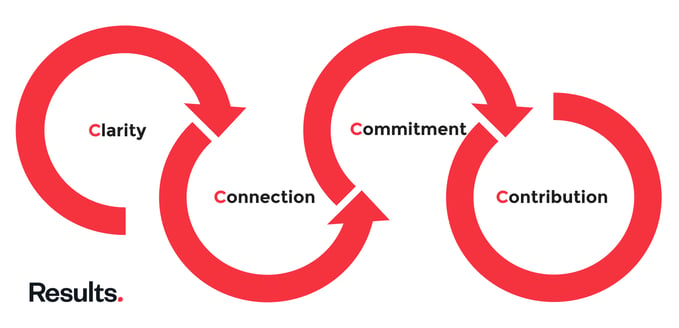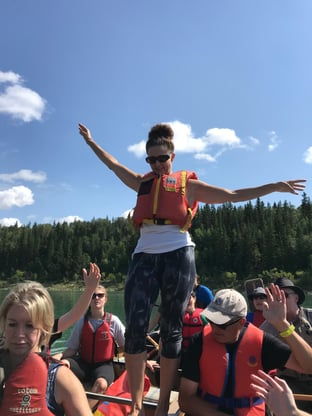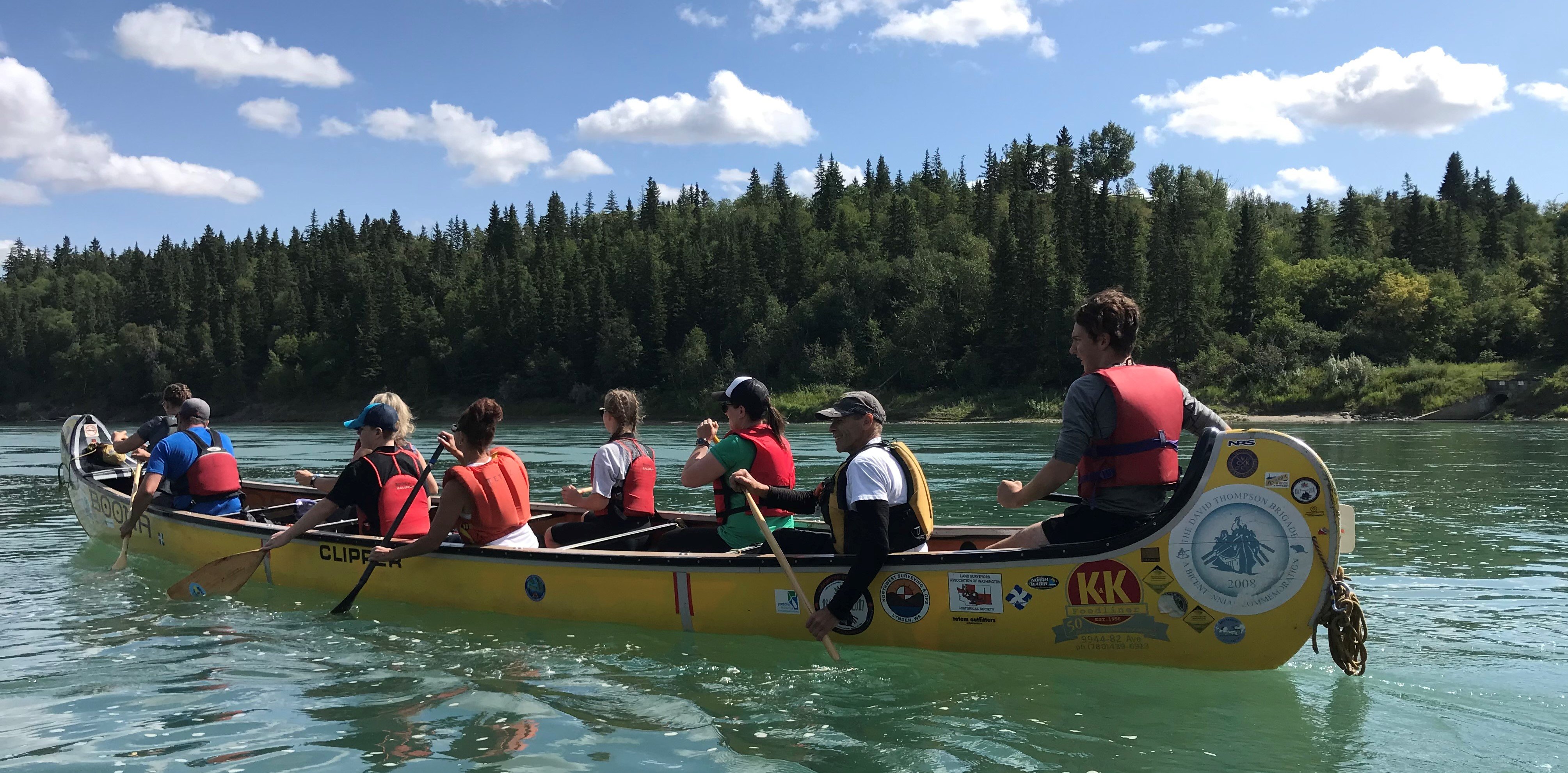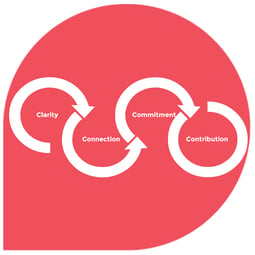Table of Contents
We all need to work in teams. Sometimes it’s a short-term task force or project team, and other times our teams are together for years like departments or senior leadership groups.
Research tells us that simply inviting a group of people to a meeting and calling them a team doesn’t necessarily result in productivity. In fact, a poorly formed and managed team can be less productive than if those individuals worked alone.
The 4 C's of Extraordinary Teams
Extraordinary teams are much more than just groups of people coming together to share work. The best teams have Clarity, Connection, Commitment and Contribution.

Clarity
Team members need to have absolute clarity of why the team exists. This is achieved through a system of goals or measures-of-success in the same way as individual roles are in an organization. There should be a core purpose for a team along with values to guide decision making and behavior.

All members should also be clear about what each member brings to the table. The best team composition includes members who have unique and differing perspectives and experience.
When work on a team is outside our normal responsibilities it can be helpful to understand the commitment and time requirement. If a project is going to take significant time away from a person’s ‘regular job,’ there needs to be methods in place to account for that. For example, if Tamela will spend 50% of her time for the next year seconded to a special project her functional department will need funding to backfill some of her responsibilities and activities.
A formal team charter can be a good way to ensure clarity by explicitly stating:
- Purpose – why does the team exist, what will it deliver, and why does it matter in the context of the organizational strategy?
- Goals – how will success be measured? What are the metrics and targets?
- Roles – what is the composition of the team? Which individuals will participate and what will their roles be?
- Scope and authority – what decisions can be made by the team? How much can it spend? What can it influence?
Connection
Trust is the foundation of teamwork. When we have trust with another person we can move faster and work in a way that drives high performance and innovation. Deep connection builds trust.
Teams with low levels of connection or trust often …:
- Miscommunicate and misunderstand one another.
- Conceal weaknesses and mistakes.
- Jump to conclusions.
- Fail to utilize each other’s skills and expertise.
- Hold grudges.
- Discuss the "real" issues after scheduled meetings.
 Building trust takes time. It’s difficult to have deep trust with a person we don’t know well or spend time with. Time creates the opportunity to understand each other’s values and unique stories.
Building trust takes time. It’s difficult to have deep trust with a person we don’t know well or spend time with. Time creates the opportunity to understand each other’s values and unique stories.
An emotional bank account is an oft used metaphor for trust and connection. With each interaction there is an opportunity to express interest in the other person, show good will, or care. Those behaviors are a deposit. Any act of ill will, indifference, or a broken promise is a withdrawal. Over time we establish a sort of ‘balance’ in the account which defines our level of trust with that person.
There are many processes teams can use to develop trust. Trust-builder exercises where people are asked to share personal experiences, lifelines, biggest fears and hopes, and other ‘non-work’ perspectives are excellent for this. Establishing a formal team launch workshop that includes behavioral profiles and communication style sharing can be very effective.
Shared personal life experiences and challenges can accelerate the trust building process. You will often hear of teams going to climb a mountain, learn to create pottery, or build homes in a poverty-stricken part of the world. These memorable moments of shared experience are times when our paths merge for a time on the journey of life.
Trust requires vulnerability and psychological safety too. The more we can open up and show our true selves the more we make room for trust.
“Great teams do not hold back with one another. They are unafraid to air their dirty laundry. They admit their mistakes, their weaknesses, and their concerns without fear of reprisal.”
- Patrick Lencioni
Great teams demonstrate and reinforce candor. Candor is the quality of being open and straightforward in communication. There are no secrets, unspoken words, or white elephants that have not been exposed for discussion. Throw out the advice our parents gave us from a young age, “if you don’t have anything nice to say, don’t say anything at all.” Candor is about getting the hard facts on the table. This is a hallmark of productive teams. If you want to learn more about candor, check out our discussion with Kim Scott, author of Radical Candor.
And finally, like any good relationship, trust on a team is never complete; it must be nurtured and maintained over time.
Commitment
Commitment is about processes and results. Every team needs to have a set of processes for interacting:- When and how they will meet?
- Who will make what decisions?
- Where is the authority?
- How will information be shared?
- When and how will options be voiced, and problems solved?
- Performance Measures.
- Delegation of work and accountability.
- Onboarding and offboarding of members.
Teams should also maintain continuous improvement loops. This would include things like rating the effectiveness of meetings (and acting on improvements that could be made), look backs or post-mortems (After Action Reviews) , and periodic alignment discussions with senior leaders. Team progress and results must contribute to the overall strategic direction of the business.
Accountability is a hallmark of committed teams. Its impossible to have a high-performing team if individual members are not accountable to the individual tasks and commitments they make. Often the team can only operate as strongly as its weakest link. Team accountability reflects the individual accountability of its members.
Contribution
Maximilien Ringelmann first observed what later became known as the Ringlemann Effect. He noticed a tendency for individual members of a group to become increasingly less productive as the size of their group increases. Ringelmann discovered that as more people are added to a group it becomes less efficient.
The main reason for this productivity loss is the breakdown in team processes. Larger teams lead to more social loafing, illusionary productivity and the common information effect.
Successful teams move from performance loss to performance gain where the output of the team is greater than the sum of its parts. This is synergy - the interaction of team members in such a way that the output is greater than the individual contributions.
Recently we experienced synergy at play when we took our Results team out to the North Saskatchewan River and learned how to propel Voyageur Canoes. Historically these canoes were used by French Canadian Voyageurs in the 18th and 19th centuries to transport furs back from the frontier. These vessels can accommodate up to 20 paddlers and can reach speeds of 11 km/hour. The Voyageurs often covered 160km per day.

“The leadership team has to find its pace. It's sort of like a rowing team, you can't just go as fast as you can. You have to row together.”
- Greg McKeown, Author of Effortless
This sort of performance was only possible through synergy. Each team member must paddle in time. Even a slight deviation can result in process loss. And at very precise moments when the leader counts down and calls for it, every paddler in time switches from one side of the canoe to the other to switch and rest opposing muscle groups. One false move or missed shift by even one paddler can capsize the vessel.
 Building Great Teams
Building Great Teams
To achieve synergy great teams need the 4Cs – Clarity, Connection, Commitment and Contribution. Team cohesion and productivity takes continue care and nurturing to deliver the synergistic effect.
If you’d like to learn more about the Results 4Cs framework or other ways you can take the simpler path to creating a great business, connect with us.
Article by Tim O’Connor



